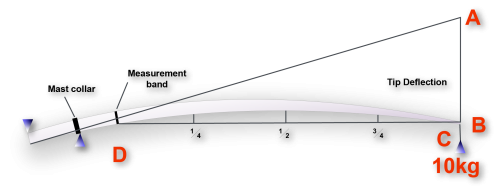Step 1.
Divide the mast into 4 sections (with 3 stripes) or 8 sections (with 7 stripes) of equal length between the two measurement bands.
Step 2.
Support the mast in a bending jig such that when bended for-aft the tip is approximately at the same height as the gooseneck above ground. For backbend measuring let the gooseneck point to the floor. For sidebend place the gooseneck at 0 degrees/ horizontal. Mark the mast at even spacings along the length of the mast between the bands.

Step 3.
For the Europe and OK Dinghy mast carefully apply exactly 10kg (large jerrycan with 10 litres of water) at the upper mastband. If it is only possible to perform the test with a 12kg weight please note this on the forms.For other masts such as the Finn please use 12kg. (these weights simulate the load that the leech of the sail puts on the mast during normal sailing conditions).
Step 4.
Tension a thin string between the two measurement bands, shown above as points D and C.
For each type of mast a spacer may need to be used to bring the reference line away from the non-sailtrack profile. For a Finn mast, 0mm, for an OK mast 7mm and for a Europe mast 11mm
This spacer should be placed between the mast and the string at point D.
Step 5.
Measure the perpendicular (at 90 degrees) distance from the lowest point of the mast at each measurement point to the upper surface of the tensioned line. Record these figures in the provided measurement form. (not yet available)
This form is suitable for use for the bend curves of all unstayed masts that Ceilidh Composite Technologies manufactures.
Please complete the form as much as possible to assist us in advising you suitably and promptly.
